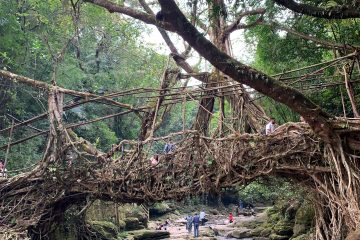Invoking the Sacred: Between Conflict and Peace in Climate Conflicts

The impacts of climate change are increasingly undermining human, national, and international security. The modern obsession with positivism and technical approaches to addressing climate-induced conflicts neglects the deeper, more spiritual dimensions that motivate and propel actors in these conflicts. That some communities treat water or land as sacred, or religious leaders bless conflicts prompts us to examine how sacred beliefs and practices could contribute to finding sustainable solutions to such conflicts. The question that emerges is: why are we having to talk about religion and spirituality and what is the reason for this blind spot? According to Justin Farrell in The Battle for Yellowstone: Morality and the Sacred Roots of Environmental Conflict, part of the answer lies in the following: first, there has been a neglect of the science of morality in environmental sociology and other disciplines; second, nature has been operationalized as a resource and a material good for survival; third, religion and spirituality have been treated as something confined to the individual; and fourth, there has been an assumption that post-Enlightenment forces of secularization were stamping out religion and spirituality.
There is increasing evidence indicating that climate change is causally associated with collective violence, generally in combination with other causal factors, such as poor economic or governance systems. Studies have shown that the risk of violent conflict in East Africa increases during periods of unfavorable climatic conditions for agriculture and pastoralism. Herders and farmers routinely competing over scarce resources, with outbreaks of outright violence and bloody inter-communal warfare, have become a common and increasingly worrying phenomenon in the Sahel region. In their fight for climate justice, some Indigenous communities assert that Indigenous sovereignty and autonomy are critical to climate justice. They wish to implement solutions guided by their Elders’ ancestral wisdom, who are the possessors of knowledge and land users. Communities such as the Sierra Nevada of Santa Marta in Colombia perceive and respond to climate change and its effects through non-human points of departure. The territory is seen and felt as an experience of the sacred in daily life and adherence to sacred life. However, to link climate change and conflict is not to suggest that climate change is always a trigger. Rather, it results in collective violence when linked to political, economic, and social instability arising from food insecurity, forced displacement, and other crises caused by extreme weather patterns. Hence it is referred to as a threat multiplier.
There is a predilection for interpreting such conflicts only in economic, instrumental, or utilitarian terms. Quantitative studies such as climatology, physics, chemistry, oceanography, physical geography, and integrative earth sciences currently dominate research on the climate-conflict nexus. As a result, earth observation technologies are deployed to observe how the world is changing, climatically and geographically. The Centre for Climate and Security observed that gaming, scenario planning and machine learning as tools and methods are employed to imagine possible future scenarios, identify patterns and networks, and demonstrate through narratives how climate-related systemic risks might manifest themselves. This approach promotes the illusion that problems in our natural agency mostly can be solved by technical innovations, mapping, measuring, and recording using technological instruments, thereby underestimating the human and cultural dimensions of global climate change. What is overlooked in this is that underlying cattle-rustling in Kenya, for instance, are prayers of blessing and protection for the cattle raiders and a strong connection between them and traditional religious leaders. Hence, merely understanding climate change and climate conflicts through the frame of technology is necessary but insufficient to fix anthropogenic environmental problems.
What does this mean for climate-proofing environmental peacebuilding? Current environmental peacebuilding responds to climate conflicts by advocating the hyperrational, inclusive and equal distribution of resources and investigations of how communities can manage common or pooled natural resources in an ecologically and socially sustainable way. While these approaches are essential and valuable, they represent the grafting of natural resource management on to already existing conflict prevention, mitigation, and resolution approaches that lend themselves to secular, positivist, and neoliberal statistical sense-making. However, as Ron E. Hassner asserts in War on Sacred Grounds, some conflicts cannot be resolved through partition, sharing, or side payments. Climate-induced conflicts over land or any environmental resource treated as sacred are perceived as indivisible, irreplaceable, inviolable, and incapable of being monetized. This challenge makes the usual trade-off strategies to solve the conflicts unworkable.
That the environmental resource cannot be partitioned leads to indivisible disputes. They are indivisible in two distinct ways. First, the resource at the center of the conflict, such as land, is perceived as indivisible in and of itself; this means it cannot be taken apart. Secondly, the resource is indivisible from those who own it, signifying that they will not consider parting with it. Dividing them or allowing competitors to take them over undermines sites which they identify with and are places at which believers can expect to communicate directly with the sacred. Resolving conflicts by establishing a value for the environmental resource, negotiating a monetary settlement, and trading, among the dominant options in traditional positivist conflict resolution strategies, may be considered insults and abhorrent by religious adherents defending sacred sites and environmental resources. Non-positivist local perceptions and rationalities could thus contribute to theoretical understandings of why people act the way they do (their motivations) in an environmental or climate conflict. Understanding stakeholders’ motivations in climate conflicts might be the key to unlocking conflicts that seem unsolvable and that recur over and over again.
Political and scientific analysis and discussions dealing with the relationship between climate change and conflicts thus require factoring in religious sense-making. This entails not only focusing on technical knowledge, reports and research, but also religion and spirituality. Ultimately, in climate conflicts there is more at stake than the natural resources, particularly in contexts where the communities involved have a religious and spiritual relationship with the natural environment. To be clear, this argument is not meant to push scientific and technical knowledge aside. Instead, it recommends pairing scientific and technical perspectives with moral, religious, and spiritual logics for a fuller comprehension of climate conflicts. The silence on how religious and spiritual logics influence stakeholders’ positions and positioning in conflicts induced by climate change is deafening. However, these might be the game-changers in resolving such conflicts.
#
Joram Tarusarira is Assistant Professor of Religion, Conflict and Peacebuilding and Director of the Centre for Religion, Conflict and Globalisation at the University of Groningen, the Netherlands. His fields of expertise include religion, conflict, peacebuilding and reconciliation; religion and politics; community development; as well as civil society and social movements. He is the Principal investigator in the project Invoking the Sacred: Towards Alternative Strategies Against Climate Conflicts. He is the author of Reconciliation and Religio-political Non-conformism in Zimbabwe (Routledge 2016) and co-editor of Themes in Religion and Human Security in Africa (Routledge 2021).
This Counterpoint blog may be reprinted with the following acknowledgement: “This article was published by Counterpoint Navigating Knowledge on 7 April 2021.”
The views and opinions expressed on this website, in its publications, and in comments made in response to the site and publications are those of the author(s) and do not necessarily reflect the views and opinions of Counterpoint: Navigating Knowledge, its founders, its staff, or any agent or institution affiliated with it, nor those of the institution(s) with which the author is affiliated. Counterpoint exists to promote vigorous debate within and across knowledge systems and therefore publishes a wide variety of views and opinions in the interests of open conversation and dialogue.
Photo credits: “Balancing Rocks,” Matobo National Park, Zimbabwe, © Travelplaninfo.com, 2021.



